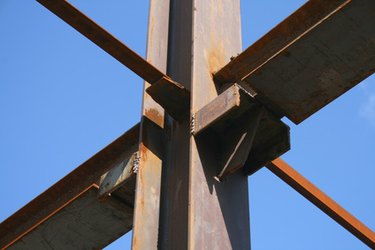
Angle irons are L-shaped metal braces used for a wide range of construction and household functions. Large angle irons often help stabilize steel beams while smaller angle irons are used to construct household items such as bed frames, benches and shelving. Most angle irons have pre-punched holes spaced at regular intervals to offer screw installation to support various weights or tensions at various lengths. For construction purposes and as supports in solid materials such as wood or metal, the weight bearing capacity of the angle iron is integral to overall structural integrity. For shelving screwed into drywall, the weight bearing capacity of the angle iron must also include calculations for the weight-bearing capacity of the anchor bolts.
Sizing and Lengths
Video of the Day
Angle irons are measured by their vertical length, horizontal length and thickness, usually in that order. So if you're looking for a 3-inch by 3-inch by ½-inch angle iron, you would specify the lengths followed by the thickness. A single angle iron that size screwed into solid wood or other solid material can support 3.9 lbs. of dead weight. If the angle iron is used for shelving, you would use at least two to hold 7.8 lbs. Three angle irons could support 11.7 lbs. By comparison, a 6-inch by 6-inch angle iron that is ½ inch thick can support 19.6 lbs and, since you would need at least two angle irons of that size to stabilize a shelf, the shelf could hold 32.9 lbs. A third angle iron would enable the shelf to hold 42.5 lbs.
Video of the Day
Angle Irons in Wallboard
Using angle irons in drywall requires an extra calculation to ensure that the load weight capacity of the angle irons don't overstress the anchor bolts or toggle bolts you need to hang shelving. Using the 6-by-6 example, a toggle bolt of 1/8-inch diameter would hold up to 30 lbs. before it would pull away from the wallboard. So, you would need a toggle bolt of twice that diameter, or ¼ inch, to handle 50 lbs. of tension weight.
Industrial and Construction Uses
Angle irons are versatile in industrial and general construction uses. There is a direct correlation between the size of an angle iron and its weight capacity. In commercial use, they are commonly used for building reinforcement, athletic flooring systems, joists, studs and control and expansion joints. Their usefulness extends to railroad track and supports, and a host of uses in the aerospace, automotive, HVAC, hardware and storage industries. When using large angle irons, you can calculate weight capacities using software.
Home Use
Angle irons make many home repair jobs easier. You can use the to support shelves, hold cabinets together, brace tabletops and chair legs and brace bookshelves to the wall to prevent them from tipping over. As a general rule of thumb, to ensure that the angle iron can support the weight required by the job, size it by the thickness of the wood it needs to support. Thus, you would use a 1/2-inch wide angle iron to hold 1/2-inch plywood, a 1-inch angle iron for nominal 1-inch lumber and and a 1 1/2-inch angle iron for nominal 2-inch lumber.